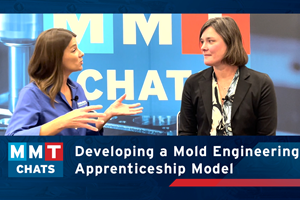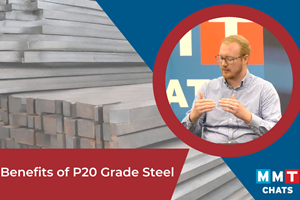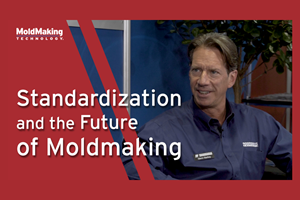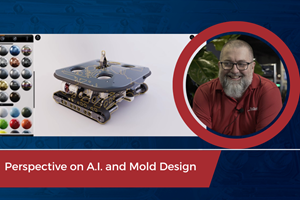VIDEO: How can 3D Printed Tooling Improve Injection Mold Venting?
Proper venting is one of a mold builders toughest challenges as molders struggle to keep vents free flowing in production. Learn how to apply 3D printing to mold venting and the benefits of additive venting inserts.
Additive venting inserts have the ability to alleviate many of the challenges associated with mold venting. Jason Murphy, president and owner of Next Chapter Manufacturing, breaks down the trends that have led to improved venting methods, including 3D-printed inserts.
Transcript
Here are four costly trends in the industry right now that are driving the need for improved venting and molds.
The first trend is that we see an increase in rising material costs. So plastics, over the last 18 months, continue to rise exponentially. We don't see that changing, so this trend will continue to rise and needs better venting, reducing scrap throughout the process and injection molding cycle.
The second reason for the need for improved venting is to be able to run recycled resins. So as materials rise and costs rise, we see the introduction 60% rise in recycled content over the next five years. So, processing recycled materials with additional heat history to them, which tends to be gassier than virgin resin, will require more venting than running 100% pure resin.
The third trend in tooling is that molds are becoming more and more complex. So the more complex the mold is the more opportunities for gas traps and the more opportunities for defects. So properly venting the molds in all those areas will enable perfect parts every time. This reduces scrap. This reduces the defect rate and produces better uptime and better profitability for molders.
The fourth trend that we see driving the need for additional venting and molds is that scrap and production are often underestimated. So a lot of times, a tooling engineer must maintain the mold and the proper condition. However, they're not responsible for the scrap number that falls into the operation side or perhaps downtime. So, where a person is not responsible for that level of scrap, those buckets can happen in different company areas but not be accounted for aggregately. This is a hidden cost that really drives the problem. A simple fix to a mold venting issue could drive into the hundreds of thousands of dollars based on rework, the labor to do the rework, sorting the extra quality assurance labor, scrap and additional downtime. So this is an area where we see the need for improved venting to alleviate this issue once and for all.
Additive venting works by using the ability to 3D print the density of the steel in different forms. Commonly in injection molding, it's the higher density of steel – again, pure density is what we're achieving – however, when we want to vent the mold out, we want to have microscopic pores that are going to allow the gas to escape but dense enough for the plastic not to escape out of the mold. So in additive manufacturing, through the direct metal laser sintering (DMLS) process, we're able to change the density of steel in a precision fashion yet keep full dense steel where it's needed in areas like shut off land areas, like for ejector pins or other critical areas that venting is not needed in but just put the venting in an area where it's absolutely required.
The key benefit of using additive venting over conventional means of venting is you're going to get an abundance of venting compared to conventional venting methods. What this is going to do is it's going to get you to your next PM. It will allow you to not have to pull the mold frequently or in an emergency situation or adopt extra cleaning or extra mold maintenance and move you more into preventative maintenance. We often recommend ultrasonically cleaning these events at your PM. This will clean out any residues in the build-up and enable the mold to run until the next PM. This saves time and money, reducing defects, which adds to the bottom line.
Related Content
MMT Chats: Developing a Mold Engineering Apprenticeship Model
New mold design and 3D printing company wanted to partner with a local high school to train mold designers and a National Tooling & Machining Association Mold Design Group Apprenticeship was the answer. This episode is brought to you by ISCAR with New Ideas for Machining Intelligently.
Read MoreProject Reveals Added Benefits of New P20 Grade Steel in Machinability, Cycle Time and No Stress Relief
MoldMaking Technology's Christina Fuges talks with General Motors' Shane Appel about a project testing a new P20 steel grade's dimensional stability.
Read MoreVIDEO: Standardization and the Future of Moldmaking
Progressive Components President Glenn Starkey discusses their focus on standardization and the future of moldmaking (it’s here to stay!).
Read MoreVIDEO: Perspective on A.I. and Mold Design
Bill Genc of TopSolid shares his perspective on the benefits of and barriers to using artificial intelligence in mold design.
Read MoreRead Next
Reasons to Use Fiber Lasers for Mold Cleaning
Fiber lasers offer a simplicity, speed, control and portability, minimizing mold cleaning risks.
Read MoreHow to Use Strategic Planning Tools, Data to Manage the Human Side of Business
Q&A with Marion Wells, MMT EAB member and founder of Human Asset Management.
Read MoreAre You a Moldmaker Considering 3D Printing? Consider the 3D Printing Workshop at NPE2024
Presentations will cover 3D printing for mold tooling, material innovation, product development, bridge production and full-scale, high-volume additive manufacturing.
Read More






















